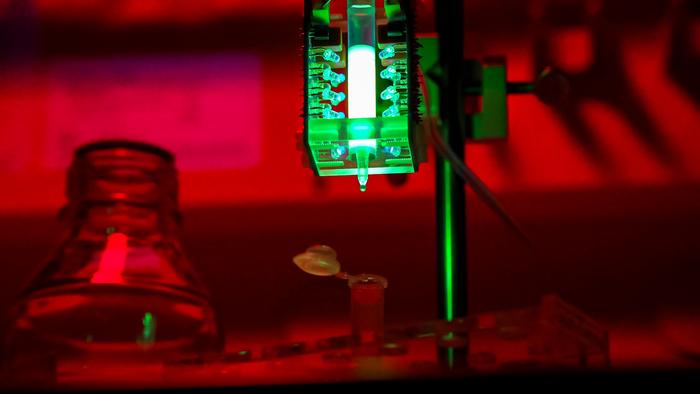
A groundbreaking advancement in the field of protein purification has emerged from scientists at the Technical University of Munich (TUM). Researchers have developed a novel method that leverages the principles of physics instead of traditional chemistry, significantly improving the efficiency and gentleness of protein extraction from cellular environments. This innovative technique is set to transform practices in molecular biology and molecular medicine, where pure proteins are crucial for investigation and pharmaceutical applications.
For decades, scientists have relied on affinity chromatography to isolate proteins from cell extracts and cultures. This conventional method involves passing the sample through a chromatography column packed with a porous carrier material, thereby binding the desired target protein. The protein is then separated from contaminants through a washing process, followed by detachment using specific chemical agents. However, this standard procedure is prone to damaging the very proteins that researchers seek to isolate, particularly during the final elution step, where the application of acids or other reagents can compromise protein integrity.
In response to these challenges, a team led by Professor Arne Skerra at TUM has pioneered a revolutionary approach that minimizes the use of harsh chemicals. Their method integrates a light-sensitive component known as the Azo-tag, which acts as a molecular anchor for the target protein and provides a means for its subsequent release without compromising quality. The development of this molecular appendage springs from the utilization of azobenzene, a light-sensitive compound capable of altering its structural conformation upon exposure to specific wavelengths of light.
At the core of this new technique is an innovative chromatography column similarly filled with a porous carrier material. However, the key distinction lies in the incorporation of LED lights encircling the column, which facilitate the illumination of the protein-bound carrier through mild ultraviolet (UV) light with a wavelength of 355 nanometers. Under normal conditions—either in daylight or darkness—the Azo-tag firmly anchors the target protein to the carrier material, allowing for the removal of non-specific contaminants.
When the LED lights are activated and the column is targeted with UV light, the Azo-tag undergoes a structural transformation, effectively detaching the target protein from the carrier without any adverse effects. This allows the protein to be eluted in a pure, concentrated state, ready for immediate use in further experiments or applications, thereby eliminating the need for further purification steps.
The researchers have successfully employed this method to purify antibodies targeting breast cancer, demonstrating its practical applicability and efficiency in biologically relevant scenarios. The initial experimental setups utilize a compact chromatography column measuring less than one centimeter in diameter, yet the research team envisions scaling this technology to accommodate larger volumes, thereby accommodating a wider range of applications.
As work continues to refine and automate the processes intrinsic to this approach, the potential for high-throughput applications in pharmaceutical and biotechnological sectors becomes evident. The authors of the study have filed a patent to protect their intellectual contributions, signaling the potential for commercialization and widespread adaptation of this innovative methodology.
The implications of this technology stretch far beyond mere efficiencies in laboratory processes; they suggest an exciting future for experimental applications in drug development and molecular biology. By circumventing traditional chemical reliance, the technique not only preserves protein integrity but also aligns with an overarching trend in scientific research to minimize environmental impact and enhance sustainability in laboratory practices.
In addition to the practical advancements this method promises, the intellectual rigor behind its development showcases the collaborative efforts of a diverse research group. The Azo-tag originated from the collective insights of researchers including Peter Mayrhofer, Markus Anneser, and Stefan Achatz, under Professor Skerra’s leadership, emphasizing the interdisciplinary nature of contemporary scientific breakthroughs.
As the realms of molecular biology and biochemistry continue to evolve, the introduction of light-based protein purification methods may represent a definitive turning point. The synergy of physical mechanisms with chemical biology principles could usher in a new standard for protein isolation, potentially redefining protocols utilized in research and pharmaceutical manufacturing for years to come.
The ongoing research efforts delineate a clear path toward the next generation of molecular techniques that prioritize gentler, more efficient methodologies for working with proteins. As this innovative approach finds its footing within the scientific community, it stands to benefit not only researchers but also patients who ultimately rely on the advancements that arise from purified and well-characterized proteins.
As scientists further develop the apparatuses to support this technique and streamline its implementation, the promise of integrating automation and high-throughput capabilities can’t be overstated. This visionary research illustrates how fundamental scientific inquiries continue to yield transformative applications, making it an exciting time to be involved in the life sciences.
The contributions of TUM’s research team serve as a testament to the ingenuity and foresight that define today’s crucial advancements in biochemistry. By placing an emphasis on protecting protein integrity and enhancing purification methods, researchers are not only reshaping academic landscapes but also paving the way for future innovations that could ultimately benefit society at large.
In summary, the emergence of this revolutionary light-based protein purification method represents a significant step forward in both scientific research and practical applications. As conventional methodologies are challenged and redefined, the landscape of molecular biology is poised for notable advancement, with the potential to improve research protocols and enhance the quality of pharmaceutical developments in the landscape of modern medical solutions.
Subject of Research: Proteins
Article Title: Protein purification with light via a genetically encoded azobenzene side chain
News Publication Date: 18-Dec-2024
Web References: Nature Communications DOI
References: Mayrhofer, P., Anneser, M.R., Schira, K. et al.
Image Credits: Sabrina Bauer / TUM
Keywords
Protein purification, chromatography, azobenzene, light-sensitive, molecular biology, biochemistry, TUM, antibodies, UV light, sustainable methods.
Tags: affinity chromatography alternativesAzo-tag technology in protein researchefficiency in protein extractiongentle protein isolation methodslight-based protein extraction methodsmolecular biology advancementspharmaceutical applications of purified proteinsphysics in molecular medicineprotein integrity preservation techniquesprotein purification techniquesrevolutionary protein purification methodsTechnical University of Munich innovations





